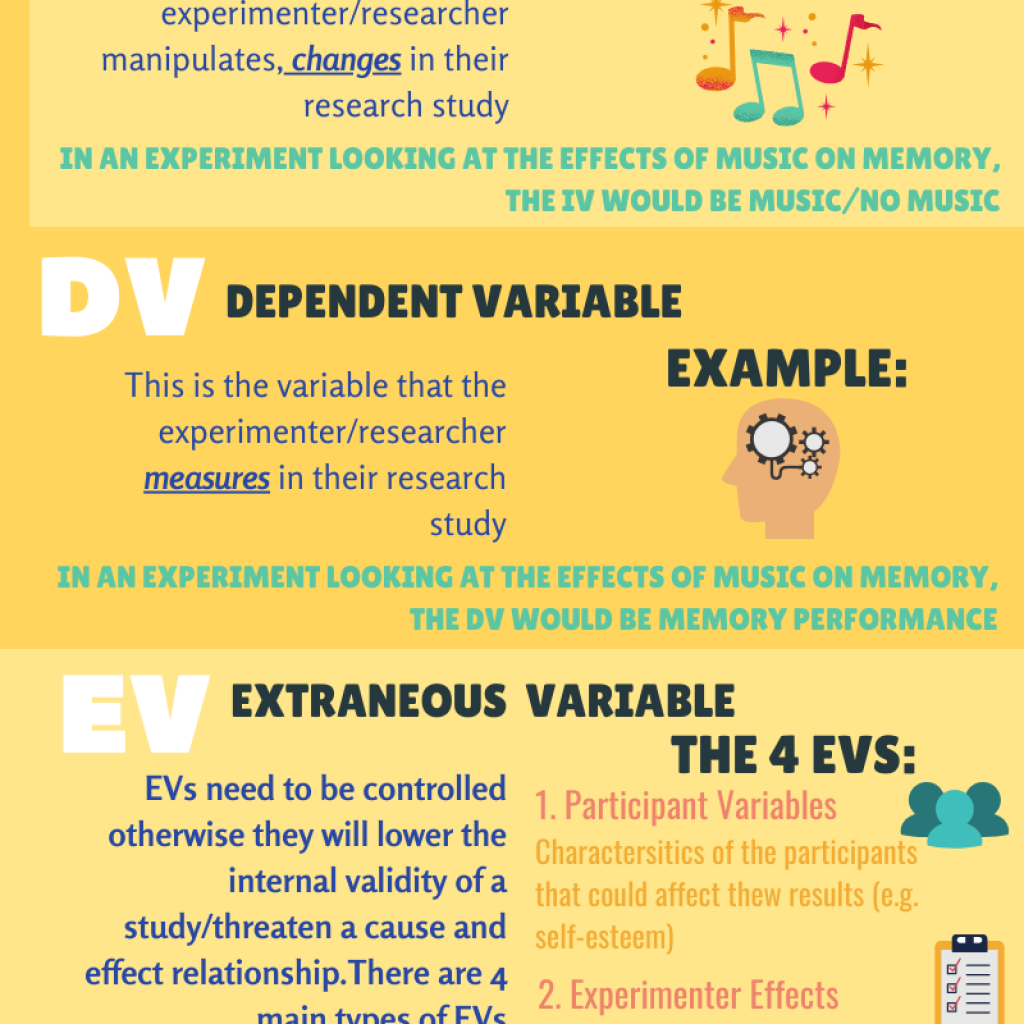
Variables In Psychological Research
March 7, 2021 - Paper 2 Psychology in Context | Research Methods
Variables: Independent And Dependent Variable
There are two main variables when it comes to psychological research, these are;
(1) The Independent Variable (IV) the variable that is manipulated/changed
(2) The Dependent Variable (DV) the variable that is measured (e.g. it measures whether or not the IV has influence human behaviour).
When carrying out a piece of research, a psychologists main concern is looking at the effects of just the IV on the DV, in order to do this, all other extraneous variables (EVs) need to be controlled.
Between the control condition and the experimental condition the only thing that should change is the IV for example, when looking at the effects of music on memory, in the control condition the participants should complete a memory test with no music playing, in the experimental condition, the participants should complete a memory test with music playing. The only thing that should change across these conditions is whether the participants complete the memory test with or without music. All other variables the memory test difficulty, age of participant, gender of participant, background noise, temperature of the room etc should remain consistent.
If a researcher controls for extraneous variables and the only variable to change across the control and experimental condition is the IV it can be seen that the research has been carried out successfully. This means that the researcher has observed the effects of just the IV on the DV, which also means that the researcher can establish a cause and effect relationship (they can be confident that the IV has been the only variable to effect the DV) and therefore can say that their experiment has high internal validity . High internal validity is when the researcher is confident that they have measured what they intended to measure (i.e. the effects of just the IV on the DV) and that all extraneous variables (EVs) have been controlled and that there are no confounding variables (CVs) in their study.
Extraneous Variables
Extraneous Variables (EVs): These are variables that researchers do not want in their research. It is important that before a researcher conducts a study they carry out a pilot study to ensure that there are no EVs that could ruin their results. There are four main extraneous variables that you need to know in your exam. It is important that you are able to describe what is meant by these four EVs and that you are able to give examples of each of the four EVs.
The four extraneous variables are:
(1) Participant Variables: This refers to anything specific to the participant that could affect the results of the research, for example, a participant’s age, gender, intelligence, personality etc
(2) Demand Characteristics: This refers to environmental clues and cues in an investigation that cause participants to behave unnaturally. Participants respond in one of the following ways:
a. Attempt to please the experimenter b. Attempt to ruin the results (‘screw you’ effect) c. Become more self-conscious
(3) Situational Variables: Refers to the experimental setting and surrounding environment must be controlled between conditions to avoid them impacting on the results, for example, the temperature of the room in which the experiment is taking place, the time of day, the weather etc
(4) Experimenter Effects: This refers to anything specific to the experimenter that could affect the results of the research, for example, the gender of the experimenter (e.g. if an experiment was taking place investigating the social life of university students a 50+ researcher may not be the best person to obtain this information from the participants as the participants may feel this person would judge their behaviours this could lead to the participants not being honest). The mood and personality of the researcher could also be experimenter effects that could impact on the results of the study.
It is important that the researcher plans their research carefully in order to remove any potential extraneous variables (EV). If an EV isn’t controlled and interferes with a study this would prevent the researcher from establishing a cause and effect relationship and would lead the study to having low internal validity the researcher will not be able to conclude that the IV is the only variable to effect the DV as an EV has been present in the study.
When a study is carried out with an extraneous variable (EV) present, this EV becomes a confounding variable (CV) due to the fact that it’s presence confounds the results of the study.
Operationalising Independent Variables (IVs) and Dependent Variables (DVs):
In experiments, the researcher manipulates the IV to find the effect it has on the DV. To preserve the internal validity of an experiment, the IV and DV must be operationalised.
Operationalising The IV And DV
Operationalisation means defining the variables (both the independent variable (IV) and the dependent variable (DV)) in such a way that they can be precisely tested and measured. More simply, operationalising variables means stating how the IV and the DV have been measured. The process of operationalising variables allows other researchers to replicate previous research studies precisely.
For example, if a researcher was looking at the effects of hunger on memory, they would have to consider how they are going to measure the IV ‘hunger’ and how they are going to measure the DV ‘memory.’
There are a number of ways in which hunger can be operationaised/measured:
(1) a questionnaire assessing hunger, the higher the score on the questionnaire could indicate a high level of hunger
(2) the amount of ghrelin present in the participant’s stomach a high amount of ghrelin indicates that the participant is hungry
(3) the amount of time passed since the person last ate (assuming that the more time that has passed since a persons last meal the more hungry they are).
There are a number of ways in which memory can be operationaised/measured the most popular method would be giving the participants a memory tests and observing the score that the participants obtain on this test.
Variable Topic Summary
Why not use the summary infographic below as a revision cue card for this topic?



